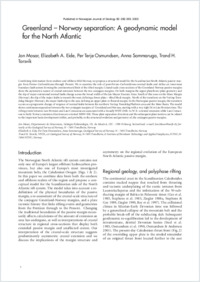Greenland – Norway separation: A geodynamic model for the North Atlantic
- Mosar, Jon Department of Geosciences, University of Fribourg, Switzerland
- Eide, Elizabeth A. Geological Survey of Norway, Trondheim, Norway
- Osmundsen, Per Terje Geological Survey of Norway, Trondheim, Norway
- Sommaruga, Anna Geological Survey of Norway, Trondheim, Norway
- Torsvik, Trond H. VISTA, c/o Geological Survey of Norway, Trondheim, & Institute of Petroleum Technology and Applied Geophysics, Norway
-
2002
Published in:
- Norwegian Journal of Geology. - 2002, vol. 82, p. 282-299
English
Combining information from onshore and offshore Mid-Norway, we propose a structural model for the Scandinavian North Atlantic passive margin from Permo- Carboniferous through Present. We re-examine the role of post-Permo-Carboniferous normal faults and define an innermost boundary fault system forming the continentward limit of the rifted margin. Crustal-scale cross-sections of the Greenland- Norway passive margins show the asymmetric nature of crustal extension between the two conjugate margins. On both margins the upper plate/lower plate geometry and the dip of major extensional normal faults change across the broad width of the Jan Mayen Fracture Zone. South of this zone on the Møre Margin (Norway), the dip of the major faults is towards the west, defining a lower plate – tilted block margin. North of the transform on the Vøring-Trøndelag Margin (Norway), the major faults dip to the east, defining an upper plate or flexural margin. In the Norwegian passive margin, the transition occurs as a progressive change of vergence of normal faults between the northern Vøring-Trøndelag Platform area and the Møre Basin. The model shows continuous separation between the two conjugate margins of Greenland and Norway, starting with a very tight fit in Late Permian time. The rifting events between Late Permian and Late Cretaceous are associated with a broadly WSW-ENE- to W-E- oriented extension while Late Cretaceous to Early Tertiary extension directions are oriented NNW-SSE. These plate separation directions and the subsequent plate motion can be related to the important basin development within, and probably, to the structural evolution and geometry of, the conjugate passive margins.
- Faculty
- Faculté des sciences et de médecine
- Department
- Département de Géosciences
- Language
-
- English
- Classification
- Geology
- Other electronic version
- License
-
License undefined
- Identifiers
-
- RERO DOC 4940
- Persistent URL
- https://folia.unifr.ch/unifr/documents/299716
Statistics
Document views: 448
File downloads:
- Texte intégral: 435
